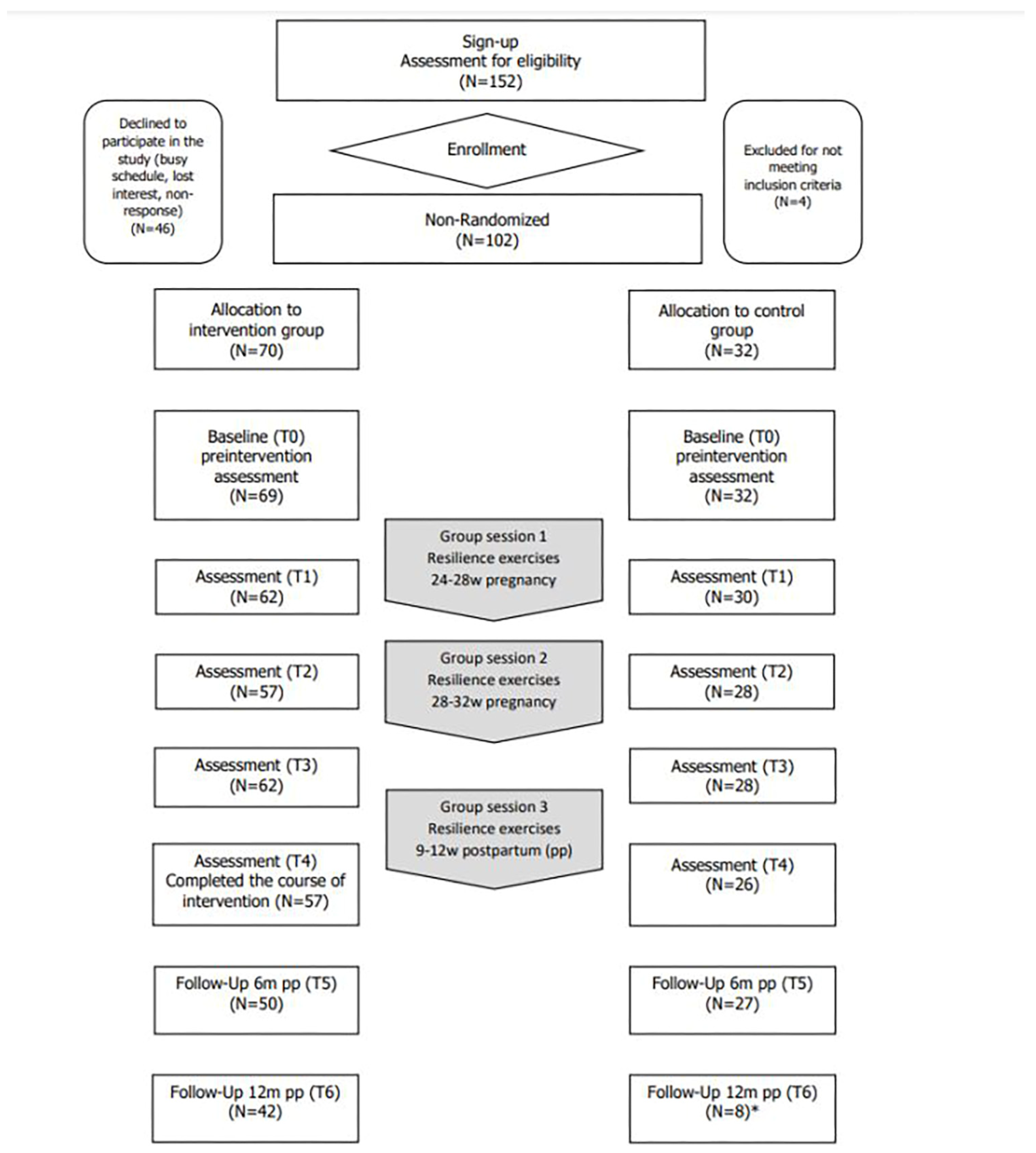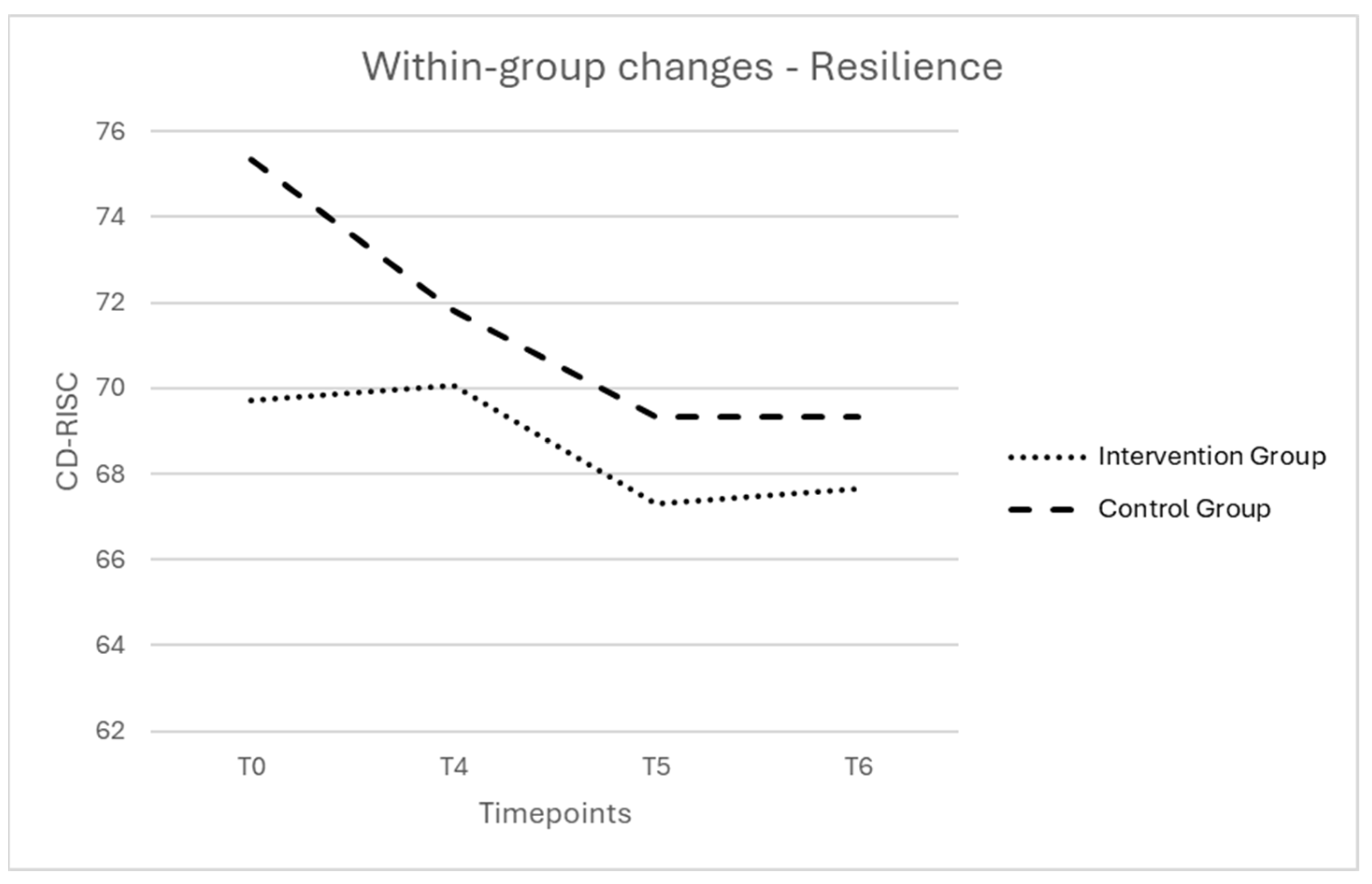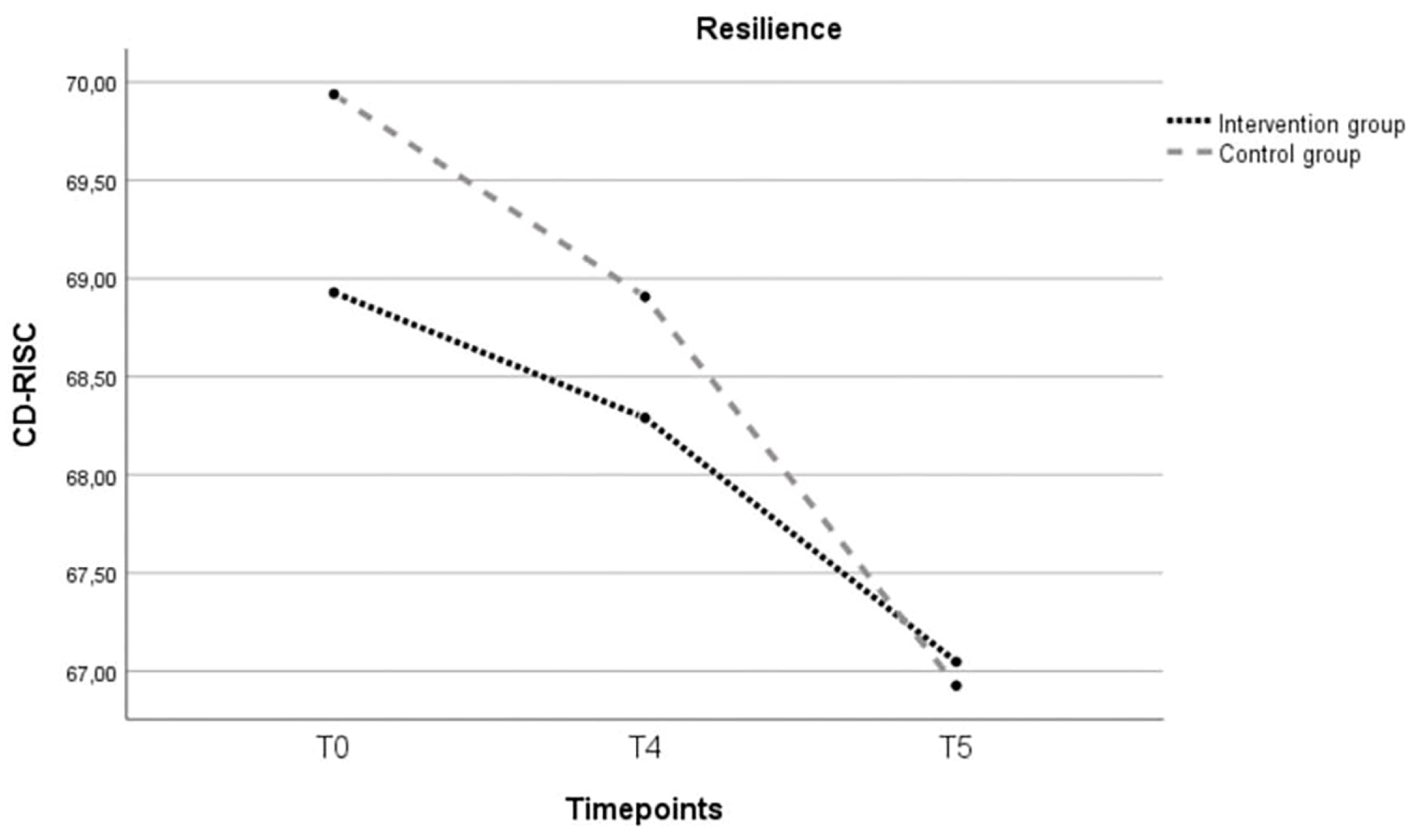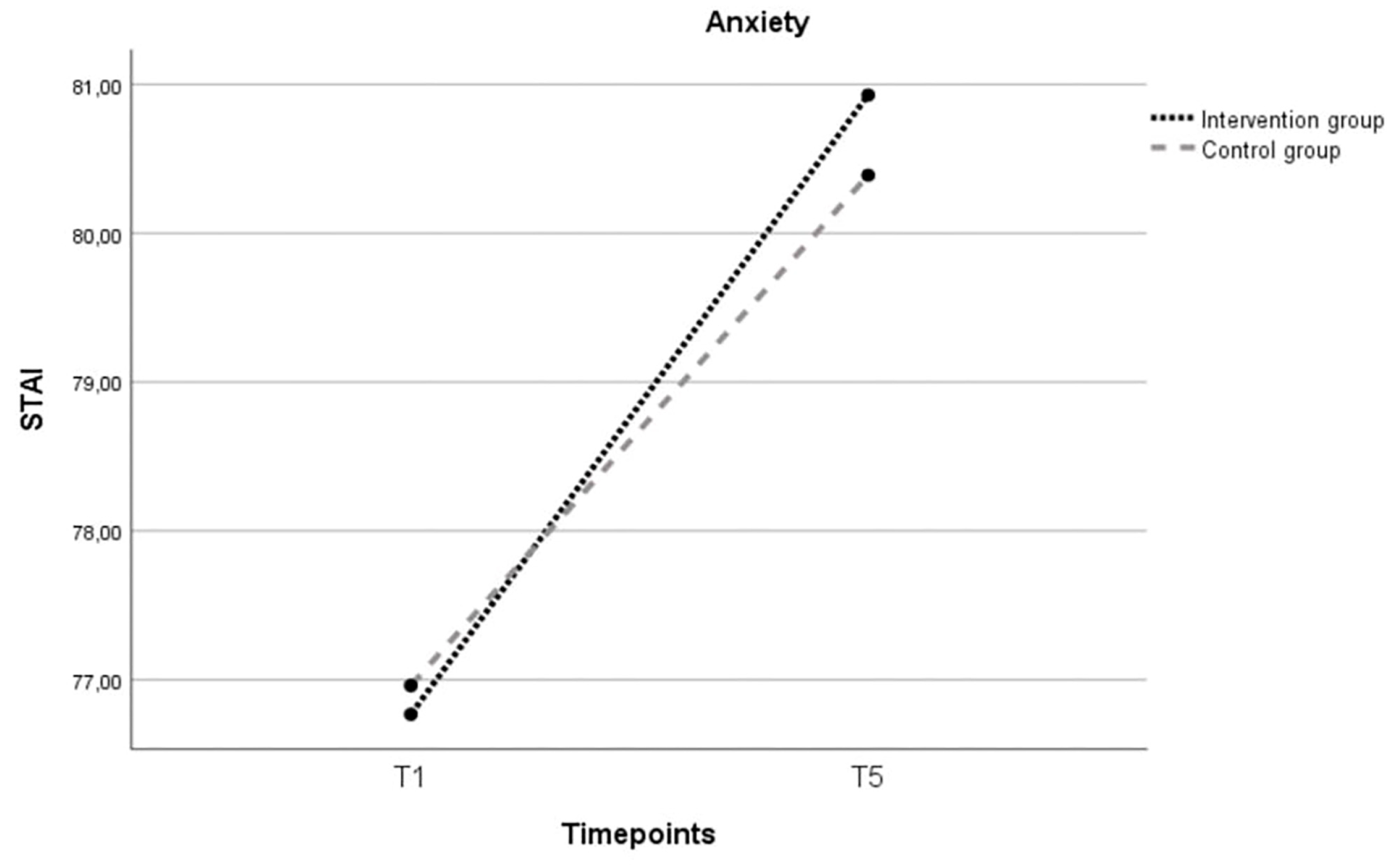A Supported Online Resilience-Enhancing Intervention for Pregnant Women: A Non-Randomized Pilot Study
Abstract
1. Introduction
2. Materials and Methods
2.1. Design and Sample Procedure
2.2. Group Assignment
2.2.1. Intervention Group
2.2.2. Control Group
2.2.3. Supported Online Resilience-Enhancing Intervention
2.3. Measures
2.3.1. Demographic Variables
2.3.2. Resilience and Perinatal Resilience Attributes
2.3.3. Maternal Mental Health
2.4. Data-Analysis
3. Results
3.1. Sample Descriptives
3.2. Within-Group Changes
3.2.1. Changes in Resilience Scores within the Intervention Group and Control Group
3.2.2. Changes in Resiliency Attributes within the Intervention Group and Control Group
3.2.3. Changes in Maternal Mental Health within the Intervention and Control Group
3.3. Between-Group Changes: Potential Effect of the Supported Online Resilience-Enhancing Intervention
3.3.1. Does Resilience Increase after Participating in the Intervention?
3.3.2. Do Maternal Mental Health Problems Decrease after Participating in the Intervention?
4. Discussion
4.1. Strengths and Limitations
4.2. Recommendations for Future Research
5. Conclusions
Author Contributions
Funding
Institutional Review Board Statement
Informed Consent Statement
Data Availability Statement
Acknowledgments
Conflicts of Interest
References
- Barber, C.C.; Masters-Awatere, B. Positively Pregnant: Development and piloting of a mobile app for social and emotional well-being in pregnancy. Appl. Psychol. Health Well-Being 2022, 14, 1255–1272. [Google Scholar] [CrossRef]
- Kumar, S.A.; Franz, M.R.; DiLillo, D.; Brock, R.L. Promoting resilience to depression among couples during pregnancy: The protective functions of intimate relationship satisfaction and self-compassion. Fam. Process 2023, 62, 387–405. [Google Scholar] [CrossRef]
- Underwood, L.; Waldie, K.; D’Souza, S.; Peterson, E.R.; Morton, S. A review of longitudinal studies on antenatal and postnatal depression. Arch. Women’s Ment. Health 2016, 19, 711–720. [Google Scholar] [CrossRef]
- Woody, C.A.; Ferrari, A.J.; Siskind, D.J.; Whiteford, H.A.; Harris, M.G. A systematic review and meta-regression of the prevalence and incidence of perinatal depression. J. Affect. Disord. 2017, 219, 86–92. [Google Scholar] [CrossRef] [PubMed]
- Fekadu Dadi, A.; Miller, E.R.; Mwanri, L. Antenatal depression and its association with adverse birth outcomes in low and middle-income countries: A systematic review and meta-analysis. PLoS ONE 2020, 15, e0227323. [Google Scholar] [CrossRef] [PubMed]
- Ghimire, U.; Papabathini, S.S.; Kawuki, J.; Obore, N.; Musa, T.H. Depression during pregnancy and the risk of low birth weight, preterm birth and intrauterine growth restriction- an updated meta-analysis. Early Hum. Dev. 2021, 152, 105243. [Google Scholar] [CrossRef] [PubMed]
- Grigoriadis, S.; Graves, L.; Peer, M.; Mamisashvili, L.; Tomlinson, G.; Vigod, S.N.; Dennis, C.-L.; Steiner, M.; Brown, C.; Cheung, A.; et al. Maternal Anxiety During Pregnancy and the Association With Adverse Perinatal Outcomes: Systematic Review and Meta-Analysis. J. Clin. Psychiatry 2018, 79, 813. [Google Scholar] [CrossRef] [PubMed]
- Gentile, S. Untreated depression during pregnancy: Short- and long-term effects in offspring. A systematic review. Neuroscience 2017, 342, 154–166. [Google Scholar] [CrossRef]
- Van den Bergh BR, H.; van den Heuvel, M.I.; Lahti, M.; Braeken, M.; de Rooij, S.R.; Entringer, S.; Hoyer, D.; Roseboom, T.; Räikkönen, K.; King, S.; et al. Prenatal developmental origins of behavior and mental health: The influence of maternal stress in pregnancy. Neurosci. Biobehav. Rev. 2020, 117, 26–64. [Google Scholar] [CrossRef]
- Walker, A.L.; Witteveen, A.B.; Otten RH, J.; Verhoeven, C.J.; Henrichs, J.; De Jonge, A. Resilience-enhancing interventions for antepartum depressive symptoms: Systematic review. BJPsych Open 2022, 8, e89. [Google Scholar] [CrossRef]
- Nillni, Y.I.; Mehralizade, A.; Mayer, L.; Milanovic, S. Treatment of depression, anxiety, and trauma-related disorders during the perinatal period: A systematic review. Clin. Psychol. Rev. 2018, 66, 136. [Google Scholar] [CrossRef]
- Da Costa, D.; Zelkowitz, P.; Nguyen, T.-V.; Deville-Stoetzel, J.-B. Mental health help-seeking patterns and perceived barriers for care among nulliparous pregnant women. Arch. Women’s Ment. Health 2018, 21, 757–764. [Google Scholar] [CrossRef] [PubMed]
- Scorza, P.; Monk, C.; Lee, S.; Feng, T.; Berry, O.O.; Werner, E. Preventing Maternal Mental Health Disorders in the Context of Poverty: Pilot Efficacy of a Dyadic Intervention. Am. J. Obstet. Gynecol. MFM 2020, 2, 100230. [Google Scholar] [CrossRef] [PubMed]
- Waqas, A.; Zafar, S.W.; Meraj, H.; Tariq, M.; Naveed, S.; Fatima, B.; Chowdhary, N.; Dua, T.; Rahman, A. Prevention of common mental disorders among women in the perinatal period: A critical mixed-methods review and meta-analysis. Glob. Ment. Health (Camb. Engl.) 2022, 9, 157–172. [Google Scholar] [CrossRef] [PubMed]
- García-León M, Á.; Caparrós-González, R.A.; Romero-González, B.; González-Perez, R.; Peralta-Ramírez, I. Resilience as a protective factor in pregnancy and puerperium: Its relationship with the psychological state, and with Hair Cortisol Concentrations. Midwifery 2019, 75, 138–145. [Google Scholar] [CrossRef] [PubMed]
- Waugh, C.E.; Koster EH, W. A resilience framework for promoting stable remission from depression. Clin. Psychol. Rev. 2015, 41, 49–60. [Google Scholar] [CrossRef] [PubMed]
- Young, C.; Ayers, S. Risk and Resilience in Pregnancy and Birth. In Multisystemic Resilience: Adaptation and Transformation in Contexts of Change; Ungar, M., Ed.; Oxford University Press: New York, NY, USA, 2021; pp. 57–58. [Google Scholar] [CrossRef]
- Van Haeken, S.; Braeken MA, K.A.; Nuyts, T.; Franck, E.; Timmermans, O.; Bogaerts, A. Perinatal Resilience for the First 1,000 Days of Life. Concept Analysis and Delphi Survey. Front. Psychol. 2020, 11, 563432. [Google Scholar] [CrossRef]
- Michie, S.; van Stralen, M.M.; West, R. The behaviour change wheel: A new method for characterising and designing behaviour change interventions. Implement. Sci. 2011, 6, 42. [Google Scholar] [CrossRef]
- Ashford, M.T.; Olander, E.K.; Ayers, S. Computer- or web-based interventions for perinatal mental health: A systematic review. J. Affect. Disord. 2016, 197, 134–146. [Google Scholar] [CrossRef]
- Van Haeken, S.; Braeken MA, K.A.; Horsch, A.; Oosterman, M.; Bogaerts, A. Development of a resilience-enhancing intervention during and after pregnancy: A systematic process informed by the behaviour change wheel framework. BMC Psychol. 2023, 11, 267. [Google Scholar] [CrossRef]
- Potharst, E.S.; Schaeffer, M.A.; Gunning, C.; de Lara, M.C.; Boekhorst MG, B.M.; Hulsbosch, L.P.; Pop VJ, M.; Duijff, S.N. Implementing “Online Communities” for pregnant women in times of COVID-19 for the promotion of maternal well-being and mother-to-infant bonding: A pretest–posttest study. BMC Pregnancy Childbirth 2022, 22, 415. [Google Scholar] [CrossRef]
- Studniczek, A.; Kossakowska, K. Experiencing Pregnancy during the COVID-19 Lockdown in Poland: A Cross-Sectional Study of the Mediating Effect of Resiliency on Prenatal Depression Symptoms. Behav. Sci. 2022, 12, 371. [Google Scholar] [CrossRef]
- Young, C.; Roberts, R.; Ward, L. Enhancing resilience in the transition to parenthood: A thematic analysis of parents’ perspectives. J. Reprod. Infant Psychol. 2021, 39, 358–370. [Google Scholar] [CrossRef] [PubMed]
- Connor, K.M.; Davidson, J.R.T. Development of a new resilience scale: The Connor-Davidson Resilience Scale (CD-RISC). Depress. Anxiety 2003, 18, 76–82. [Google Scholar] [CrossRef] [PubMed]
- Zimet, G.D.; Powell, S.S.; Farley, G.K.; Werkman, S.; Berkoff, K.A. Psychometric characteristics of the Multidimensional Scale of Perceived Social Support. J. Personal. Assess. 1990, 55, 610–617. [Google Scholar] [CrossRef] [PubMed]
- Rosenberg, M. Society and the Adolescent Self-Image; Princeton University Press: Princeton, NJ, USA, 1965. [Google Scholar]
- Schwarzer, R.; Jerusalem, M. Generalized Self-Efficacy scale. In Measures in Health Psychology: A User’s Portfolio. Causal and Control Beliefs; Weinman, J., Wright, S., Johnston, M., Eds.; NFER-NELSON: Windsor, UK, 1995; pp. 35–37. [Google Scholar]
- Baer, R.A.; Smith, G.T.; Hopkins, J.; Krietemeyer, J.; Toney, L. Using self-report assessment methods to explore facets of mindfulness. Assessment 2006, 13, 27–45. [Google Scholar] [CrossRef] [PubMed]
- Cox, J.L.; Holden, J.M.; Sagovsky, R. Detection of postnatal depression. Development of the 10-item Edinburgh Postnatal Depression Scale. Br. J. Psychiatry J. Ment. Sci. 1987, 150, 782–786. [Google Scholar] [CrossRef]
- Spielberger, C.D.; Gorsuch, R.L.; Lushene, R.; Vagg, P.R.; Jacobs, G.A. Manual for the State-Trait Anxiety Inventory; Consulting Psychologists Press: Palo Alto, CA, USA, 1983. [Google Scholar]
- Ceulemans, M.; Hompes, T.; Foulon, V. Mental health status of pregnant and breastfeeding women during the COVID-19 pandemic: A call for action. Int. J. Gynecol. Obstet. 2020, 151, 146–147. [Google Scholar] [CrossRef] [PubMed]
- Lebel, C.; MacKinnon, A.; Bagshawe, M.; Tomfohr-Madsen, L.; Giesbrecht, G. Elevated depression and anxiety symptoms among pregnant individuals during the COVID-19 pandemic. J. Affect. Disord. 2020, 277, 5–13. [Google Scholar] [CrossRef]
- Preis, H.; Mahaffey, B.; Heiselman, C.; Lobel, M. Vulnerability and resilience to pandemic-related stress among U.S. women pregnant at the start of the COVID-19 pandemic. Soc. Sci. Med. 2020, 266, 113348. [Google Scholar] [CrossRef]
- Janitra, F.E.; Jen, H.-J.; Chu, H.; Chen, R.; Pien, L.-C.; Liu, D.; Lai, Y.-J.; Banda, K.J.; Lee, T.-Y.; Lin, H.-C.; et al. Global prevalence of low resilience among the general population and health professionals during the COVID-19 pandemic: A meta-analysis. J. Affect. Disord. 2023, 332, 29–46. [Google Scholar] [CrossRef]
- Sim, A.; Bowes, L.; Gardner, F. The Promotive Effects of Social Support for Parental Resilience in a Refugee Context: A Cross-Sectional Study with Syrian Mothers in Lebanon. Prev. Sci. 2019, 20, 674–683. [Google Scholar] [CrossRef]
- Melville, K.M.; Casey, L.M.; Kavanagh, D.J. Dropout from Internet-based treatment for psychological disorders. Br. J. Clin. Psychol. 2010, 49, 455–471. [Google Scholar] [CrossRef]
- Stephens, S.; Ford, E.; Paudyal, P.; Smith, H. Effectiveness of Psychological Interventions for Postnatal Depression in Primary Care: A Meta-Analysis. Ann. Fam. Med. 2016, 14, 463–472. [Google Scholar] [CrossRef] [PubMed]
- Corno, G.; Etchemendy, E.; Espinoza, M.; Herrero, R.; Molinari, G.; Carrillo, A.; Drossaert, C.; Baños, R.M. Effect of a web-based positive psychology intervention on prenatal well-being: A case series study. Women Birth 2018, 31, e1–e8. [Google Scholar] [CrossRef] [PubMed]
- Fonseca, A.; Alves, S.; Monteiro, F.; Gorayeb, R.; Canavarro, M.C. Be a Mom, a Web-Based Intervention to Prevent Postpartum Depression: Results From a Pilot Randomized Controlled Trial. Behav. Ther. 2020, 51, 616–633. [Google Scholar] [CrossRef]
- Loughnan, S.A.; Joubert, A.E.; Grierson, A.; Andrews, G.; Newby, J.M. Internet-delivered psychological interventions for clinical anxiety and depression in perinatal women: A systematic review and meta-analysis. Arch. Women’s Ment. Health 2019, 22, 737–750. [Google Scholar] [CrossRef]
- Mackintosh, N.; Agarwal, S.; Adcock, K.; Armstrong, N.; Briley, A.; Patterson, M.; Sandall, J.; Gong, Q. Online resources and apps to aid self-diagnosis and help seeking in the perinatal period: A descriptive survey of women’s experiences. Midwifery 2020, 90, 102803. [Google Scholar] [CrossRef]
- Hussain-Shamsy, N.; Shah, A.; Vigod, S.N.; Zaheer, J.; Seto, E. Mobile Health for Perinatal Depression and Anxiety: Scoping Review. J. Med. Internet Res. 2020, 22, e17011. [Google Scholar] [CrossRef] [PubMed]
- Chae, J.; Kim, H.K. Internet-based prenatal interventions for maternal health among pregnant women: A systematic review and meta-analysis. Child. Youth Serv. Review 2021, 127, 106079. [Google Scholar] [CrossRef]
- Paul, J.J.; Dardar, S.; River, L.M.; St John-Larkin, C. Telehealth adaptation of perinatal mental health mother–infant group programming for the COVID-19 pandemic. Infant Ment. Health J. 2022, 43, 85–99. [Google Scholar] [CrossRef] [PubMed]
- Nuyts, T.; Van Haeken, S.; Crombag, N.; Singh, B.; Ayers, S.; Garthus-Niegel, S.; Braeken MA, K.A.; Bogaerts, A. ‘Nobody Listened’. Mothers’ Experiences and Needs Regarding Professional Support Prior to Their Admission to an Infant Mental Health Day Clinic. Int. J. Environ. Res. Public Health 2021, 18, 10917. [Google Scholar] [CrossRef] [PubMed]
- Ayers, S.; Crawley, R.; Alderdice, F.; Eagle, A. Personalised approaches to intervention for perinatal mental health difficulties. J. Reprod. Infant Psychol. 2021, 39, 339–341. [Google Scholar] [CrossRef] [PubMed]
- Hill, I.; Burroughs, E. Maternal Telehealth Has Expanded Dramatically during the COVID-19 Pandemic: Equity Concerns and Promising Approaches; Urban Institute: Washington, DC, USA, 2020. [Google Scholar]





| Scales | T0 (Baseline) | T1 (28–32 w) | T2 (32–36 w) | T3 (3 w pp) | T4 (12 w pp) | T5 (6 m pp) | T6 (12 m pp) |
|---|---|---|---|---|---|---|---|
| CD-RISC | X | X | X | X | X | X | |
| MSPSS | X | X | X | ||||
| RSES | X | X | X | ||||
| GSES | X | X | X | ||||
| FFMQ | X | X | X | ||||
| EPDS | X | X | X | ||||
| STAI | X | X |
| Intervention Group (N = 70) | Control Group (N = 32) | Group Differences (p-Value) | |
|---|---|---|---|
| Sociodemographic Characteristics | |||
| Age in years Mean (SD) * | 33.7 (4.24) | 29.1 (3.49) | 0.00 |
| Marital status (%) | |||
| Married or legally cohabiting | 97.1 | 93.8 | |
| Single | 2.9 | 6.3 | |
| Education level (%) | 0.683 | ||
| Secondary education | 8.6 | 6.3 | |
| Bachelor’s degree | 44.3 | 37.5 | |
| Master’s degree | 47.1 | 56.3 | |
| Occupation (%) | 0.202 | ||
| Employee | 50.0 | 68.8 | |
| Civil servant | 24.3 | 15.6 | |
| Self-employment | 10.0 | 6.3 | |
| Pregnancy leave | 5.7 | 9.4 | |
| Family income/month (%) | 0.853 | ||
| EUR 1500–2000 | 1.4 | 3.1 | |
| EUR 2000–3000 | 5.7 | 12.5 | |
| EUR 3000–4000 | 44.3 | 40.6 | |
| EUR 4000–5000 | 37.1 | 31.3 | |
| >5000 EUR | 8.6 | 9.4 | |
| Unknown | 2.8 | 3.1 | |
| Nationality | 1.000 | ||
| Belgian | 98.6 | 96.9 | |
| Other Western country | 1.4 | 3.1 | |
| Pregnancy-related characteristics | |||
| Parity (%) | 0.813 | ||
| Primiparous | 77.1 | 75.0 | |
| Multiparous | 22.9 | 25.0 | |
| Method of conception | 0.569 | ||
| Spontaneous | 87.1 | 90.6 | |
| Hormone treatment | 5.7 | 6.3 | |
| IVF/ICSI | 7.1 | 3.1 | |
| History of miscarriage % | 1.000 | ||
| No | 88.6 | 90.6 | |
| Yes | 11.4 | 9.4 | |
| Alcohol use during pregnancy | 0.0 | 0.0 | |
| Smoking during pregnancy | 0.0 | 0.0 | |
| Intervention Group | ||||||||||||
|---|---|---|---|---|---|---|---|---|---|---|---|---|
| Construct | Baseline (T0) | 32–36 w (T2) | 3 w pp (T3) | Post Intervention (T4) | Follow-up 6 m pp (T5) | Follow-up 12 m pp (T6) | ||||||
| M | SD | M | SD | M | SD | M | SD | M | SD | M | SD | |
| Resilience | 69.09 | 12.36 | 68.61 | 11.47 | 69.70 | 11.09 | 69.02 | 10.93 | 67.02 | 13.32 | 68.09 | 13.69 |
| N = 65 | N = 57 | N = 62 | N = 57 | N = 50 | N = 42 | |||||||
| Social support | 75.60 | 8.05 | 75.72 | 8.57 | 73.64 | 9.96 | ||||||
| N = 69 | N = 57 | N = 53 | ||||||||||
| Self-esteem | 20.80 | 4.32 | 21.18 | 4.61 | 20.55 | 4.89 | ||||||
| N = 57 | N = 54 | N = 53 | ||||||||||
| General self-efficacy | 30.52 | 4.38 | 30.48 | 3.94 | 30.11 | 4.87 | ||||||
| N = 67 | N = 57 | N = 53 | ||||||||||
| Sense of mastery | 125.49 | 17.07 | 123.59 | 16.86 | 124.56 | 18.50 | ||||||
| N = 55 | N = 49 | N = 53 | ||||||||||
| T1 | T4 | T5 | T6 | |||||||||
| Depression | 7.26 | 4.18 | 7.66 | 4.87 | 8.43 | 5.31 | ||||||
| N = 62 | N = 56 | N = 53 | ||||||||||
| Anxiety | 76.94 | 21.13 | 82.53 | 22.21 | ||||||||
| N = 61 | N = 49 | |||||||||||
| Stait anxiety | 38.44 | 12.34 | 41.09 | 12.61 | ||||||||
| N = 62 | N = 52 | |||||||||||
| Trait anxiety | 38.73 | 9.53 | 40.64 | 10.45 | ||||||||
| N = 61 | N = 51 | |||||||||||
| Control Group | ||||||||||||
| Construct | Baseline (T0) | 32–36 w (T2) | 3 w pp (T3) | Post Intervention (T4) | Follow-up 6 m pp (T5) | Follow-up 12 m pp (T6) | ||||||
| M | SD | M | SD | M | SD | M | SD | M | SD | M | SD | |
| Resilience | 72.17 | 8.31 | 71.53 | 10.27 | 69.71 | 10.75 | 71.42 | 11.04 | 69.85 | 10.58 | 69.37 | 5.29 |
| N = 28 | N = 28 | N = 28 | N = 26 | N = 27 | N = 8 * | |||||||
| Social support | 79.41 | 6.00 | 78.40 | 5.98 | 79.18 | 5.60 | ||||||
| N = 31 | N = 57 | N = 25 | ||||||||||
| Self-esteem | 22.06 | 4.97 | 22.46 | 4.38 | 22.18 | 4.91 | ||||||
| N = 30 | N = 54 | N = 24 | ||||||||||
| General self-efficacy | 31.90 | 3.75 | 31.04 | 3.40 | 31.50 | 4.13 | ||||||
| N = 31 | N = 57 | N = 26 | ||||||||||
| Sense of mastery | 132.83 | 11.06 | 129.51 | 11.64 | 130.92 | 11.82 | ||||||
| N = 30 | N = 49 | N = 27 | ||||||||||
| T1 | T4 | T4 | T5 | |||||||||
| Depression | 6.83 | 4.43 | 5.77 | 4.10 | 6.27 | 3.69 | ||||||
| N = 30 | N = 56 | N = 26 | ||||||||||
| Anxiety | 72.50 | 16.79 | 74.85 | 16.09 | ||||||||
| N = 26 | ||||||||||||
| Stait anxiety | 35.77 | 9.12 | 38.38 | 9.45 | ||||||||
| N = 27 | - | N = 26 | ||||||||||
| Trait anxiety | 36.50 | 8.23 | 36.46 | 8.04 | ||||||||
| N = 28 | N = 26 | |||||||||||
Disclaimer/Publisher’s Note: The statements, opinions and data contained in all publications are solely those of the individual author(s) and contributor(s) and not of MDPI and/or the editor(s). MDPI and/or the editor(s) disclaim responsibility for any injury to people or property resulting from any ideas, methods, instructions or products referred to in the content. |
© 2024 by the authors. Licensee MDPI, Basel, Switzerland. This article is an open access article distributed under the terms and conditions of the Creative Commons Attribution (CC BY) license (https://creativecommons.org/licenses/by/4.0/).
Share and Cite
Van Haeken, S.; Braeken, M.A.K.A.; Groenen, A.; Bogaerts, A. A Supported Online Resilience-Enhancing Intervention for Pregnant Women: A Non-Randomized Pilot Study. Int. J. Environ. Res. Public Health 2024, 21, 209. https://doi.org/10.3390/ijerph21020209
Van Haeken S, Braeken MAKA, Groenen A, Bogaerts A. A Supported Online Resilience-Enhancing Intervention for Pregnant Women: A Non-Randomized Pilot Study. International Journal of Environmental Research and Public Health. 2024; 21(2):209. https://doi.org/10.3390/ijerph21020209
Chicago/Turabian StyleVan Haeken, Sarah, Marijke Anne Katrien Alberta Braeken, Anne Groenen, and Annick Bogaerts. 2024. "A Supported Online Resilience-Enhancing Intervention for Pregnant Women: A Non-Randomized Pilot Study" International Journal of Environmental Research and Public Health 21, no. 2: 209. https://doi.org/10.3390/ijerph21020209
APA StyleVan Haeken, S., Braeken, M. A. K. A., Groenen, A., & Bogaerts, A. (2024). A Supported Online Resilience-Enhancing Intervention for Pregnant Women: A Non-Randomized Pilot Study. International Journal of Environmental Research and Public Health, 21(2), 209. https://doi.org/10.3390/ijerph21020209






